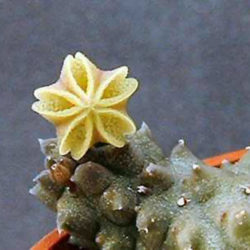Scientific Name
Pectinaria namaquensis (N.E.Br.) Plowes
Synonym(s)
Pectinaria articulata subsp. namaquensis, Pectinaria articulata var. namaquensis
Scientific Classification
Family: Apocynaceae
Subfamily: Asclepiadoideae
Genus: Pectinaria
Description
Pectinaria namaquensis is a rare succulent that forms mats of short branched stems that grow up to 3 inches (7.5 cm) long and 0.5 inches (1.3 cm) in diameter.
Flowers are greenish-yellow or purple-red, characterized by corolla lobes united at their tips, hiding much of the flower interior from sight. Only narrow openings are left between the lobes for tiny insects to access the flower parts involved in pollination.

Hardiness
USDA hardiness zone 10a to 11b: from 30 °F (−1.1 °C) to 50 °F (+10 °C).
How to Grow and Care
Stapeliads are relatively easy to grow. However, they should be treated as outdoor plants as they will easily rot indoors and cannot flower without exposure to outdoor temperature fluctuations. They should be grown under cover so that watering can be controlled. They require a reasonable amount of sunlight to promote flowering and maintain a well-shaped plant. Very shady positions will produce very poor flowering. Stapeliads come from climates where they survive extremely high temperatures in the summer months, so most growth is in spring and autumn, with flowering in autumn when the weather starts to cool down. Water in moderation when needed in the growing season, making sure soil is fairly dried out between waterings. Do not water between November 1 and March 1.
The easiest and best way to propagate Stapeliads is from stem cuttings which can be taken virtually throughout the year. Seed is also a method of propagation.
See more at How to Grow and Care for Stapeliads.
Origin
Pectinaria namaquensis is native to South Africa.
Links
- Back to genus Pectinaria
- Succupedia: Browse succulents by Scientific Name, Common Name, Genus, Family, USDA Hardiness Zone, Origin, or cacti by Genus
Photo Gallery
Click on a photo to see a larger version.


